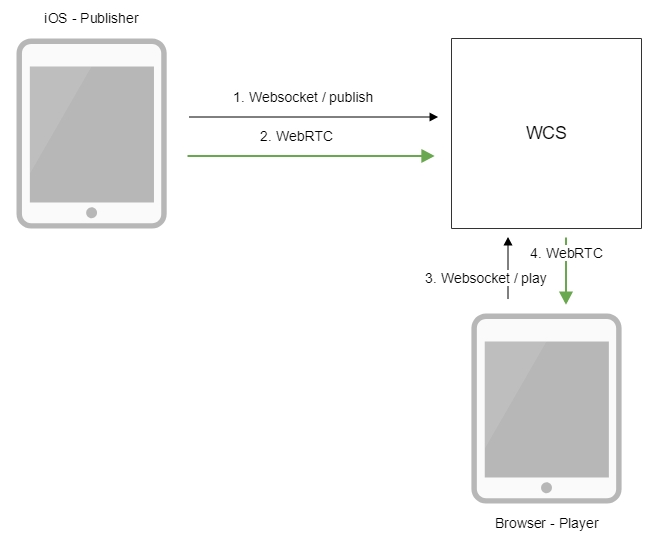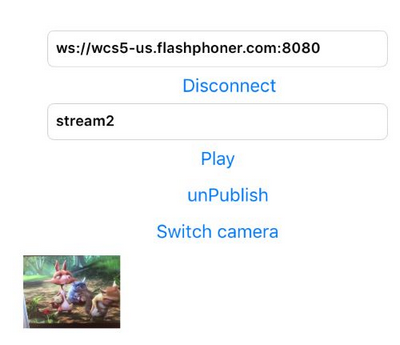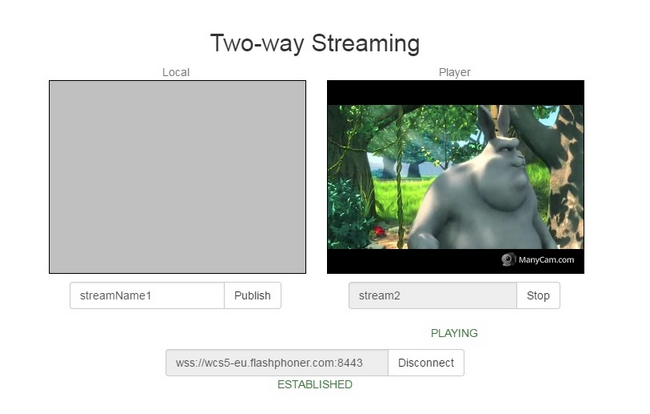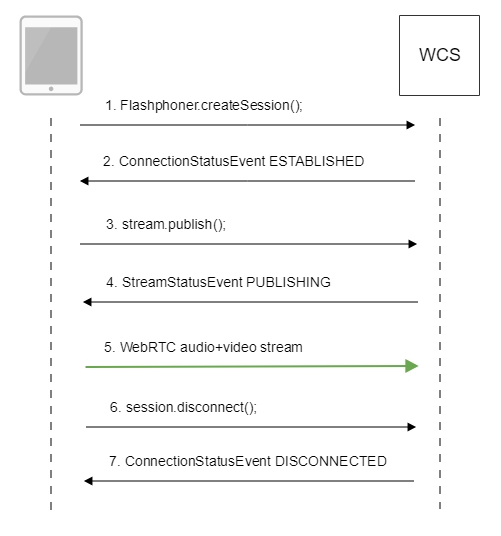From an iOS mobile app via WebRTC¶
Overview¶
WCS provides SDK to develop client applications for the iOS platform
Operation flowchart¶

- The iOS device connects to the server via the Websocket protocol and sends the
publishStreamcommand. - The iOS device captures the microphone and the camera and sends the WebRTC stream to the server.
- The browser establishes a connection via WebSocket and sends the
playStreamcommand. - The browser receives the WebRTC stream and plays that stream on the page
Quick manual on testing¶
- For the test we use:
- the demo server at
wcs5-us.flashphoner.com; - the mobile application for iOS;
-
the Two Way Streaming web application to display the captured stream
-
Start the application on iPhone. Enter the URL of the WCS server and the name of the stream. Publish the stream by clicking
Publish:

-
Open the Two Way Streaming web application. In the field just below the player window enter the name of the stream broadcast from iPhone, and click the
Playbutton. The browser starts playing the stream:

Call flow¶
Below is the call flow when using the Streamer example

-
Establishing a connection to the server
FPWCSApi2.createSession()code
FPWCSApi2SessionOptions *options = [[FPWCSApi2SessionOptions alloc] init]; NSURL *url =[[NSURL alloc] initWithString:_connectUrl.text]; options.urlServer = [NSString stringWithFormat:@"%@://%@:%@", url.scheme, url.host, url.port]; streamName = [url.path.stringByDeletingPathExtension stringByReplacingOccurrencesOfString: @"/" withString:@""]; options.appKey = @"defaultApp"; NSError *error; session = [FPWCSApi2 createSession:options error:&error]; -
Receiving from the server an event confirming successful connection
FPWCSApi2Session.on:kFPWCSSessionStatusEstablished callbackcode
-
Publishing the stream
FPWCSApi2Session.createStream()code
FPWCSApi2Session *session = [FPWCSApi2 getSessions][0]; FPWCSApi2StreamOptions *options = [[FPWCSApi2StreamOptions alloc] init]; options.name = streamName; options.display = _videoView.local; if ( UI_USER_INTERFACE_IDIOM() == UIUserInterfaceIdiomPad ) { options.constraints = [[FPWCSApi2MediaConstraints alloc] initWithAudio:YES videoWidth:640 videoHeight:480 videoFps:15]; } NSError *error; publishStream = [session createStream:options error:&error]; -
Receiving from the server an event confirming successful publishing of the stream
FPWCSApi2Stream.on:kFPWCSStreamStatusPublishing callbackcode
-
Sending audio and video stream via WebRTC
-
Stopping publishing of the stream
FPWCSApi2Session.disconnect()code
if ([button.titleLabel.text isEqualToString:@"STOP"]) { if ([FPWCSApi2 getSessions].count) { FPWCSApi2Session *session = [FPWCSApi2 getSessions][0]; NSLog(@"Disconnect session with server %@", [session getServerUrl]); [session disconnect]; } else { NSLog(@"Nothing to disconnect"); [self onDisconnected]; } } else { //todo check url is not empty [self changeViewState:_connectUrl enabled:NO]; [self connect]; } -
Receiving from the server an event confirming successful unpublishing of the stream
FPWCSApi2Sessionon:kFPWCSSessionStatusDisconnected callbackcode